Paris’ Velib was a pioneer of municipal urban bike sharing. Still today it remains the very best way to get around the French capital, open to tourists and residents alike for a miraculously tiny fee. But how to get the most from it? Below is our extensive guide.
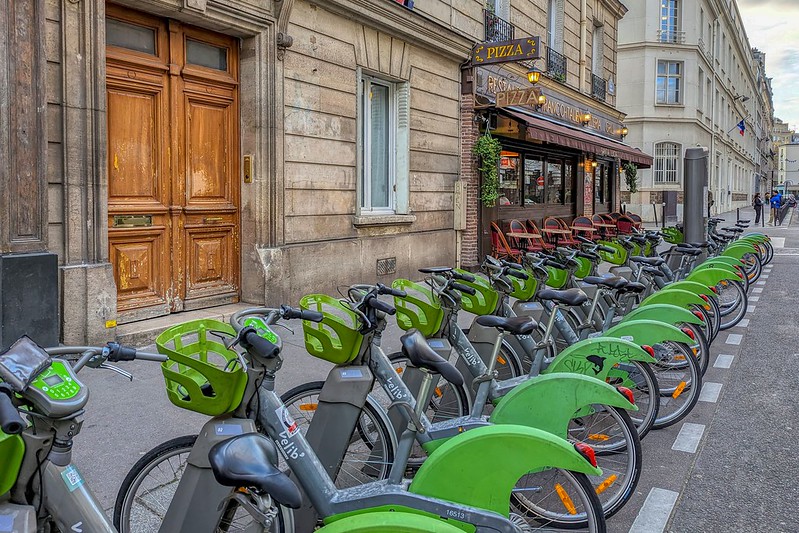
Velibs in all their glory (Photo: besopha via Flickr / CC BY 2.0)
On a Shared Knowledge
A few weeks ago, half a bottle of red wine deep into a Paris evening, a new friend and I discovered a whole passion and area of expertise we’d hitherto not known we had.
“From Montmartre to Sainte Lazaare, you mount the curb against the traffic for about twenty metres on the rue the Clichy.” “To connect to rue de Parme?” “Yes!” “And you know parking near the Tuileries.” “Ah, it’s such a pain.” “But you’re always more likely to find space, you know on—” “Rue St Honoré?” “Exactly!” “And how about Republique, how’d you cross it?” “Straight over, if I’m going to the Seine.” “Because you have to set up for the lane in the middle of rue du Temple.” “Exactly.”
That’s right, like a couple of London cabbies, there we were luxuriating in our Knowledge. Though not of the British capital, but the French one, and learned not from behind the wheel of a taxi, but rather on the saddle of Velib – Paris’s municipal bike share service, that between us we’d had over twenty years’ experience riding.
I have been an evangelist for the system since the start. For in the contraction of liberté that makes up Velib’s second syllable is everything the service offers: it is freedom from and freedom to. Velibs are freedom from the interminable snarl of motorised urban transport, the stomach knotting of a rising taxi meter, and the foetid trenches of a metro crush. And they are freedom to reach almost any nook of one of the world’s greatest cities in less than half an hour, to flaneur the Hausmann boulevards and at pace more appropriate than walking for the modern age, and most important of all the freedom to not cycle: to not have to worry about thieves, or getting too drunk, or a turn in the weather. For a Velib is the city’s responsibility the moment you return it to its station.
This said, the system is not perfect. The bikes exist in a constant battle against the wear and tear rendered them by Paris’s people and its streets – frequently they are encountered with faulty gears, missing peddles, loose breaks, or simply battered beyond use. Then, there’s their irretractable relationship to urban tides. The bikes are limited in number, and their docking ports are too, making them harder to find in places and times where everyone wants them, and harder to park wherever everyone wants to go. And of course there’s also the unavoidable reality that cycling in a city can be dangerous, especially down certain roads, especially over certain intersections, especially where the bike lanes have been ill-considered and everyone ends up breaking the rules.
In my years of riding, though, I now realised I had built up countless small hacks to the system: a mental handbook of expertise that was also a secret history of sorts. For in that conversation with my new friend I was discovering just how many city dwellers held such a repertoire of knowledge that they never think to share. So I decided to write as much of it down as I could; to share what I know.
Hopefully there will be some things here that have not occurred to even the most veteran Veliber. Mainly, though, this is for the beginner, for visitors to Paris, who I implore to try this municipal transport miracle. And indeed to saddle up on other such systems in other cities around the world as well. For though this is a guide to the Paris Velib, I trust too there is transferable knowledge in it, just as relevant to the bike shares of Marseille, London, Rome, and many more.
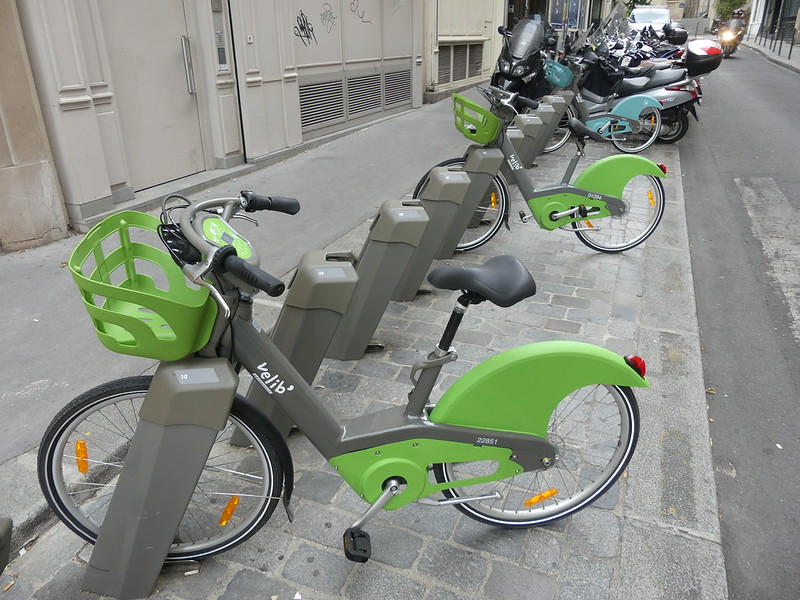
Slimmer pickings (Photo: Simone Ramella via Flickr / CC BY 2.0)
On the Simple Stuff
I’m going to assume that you’ve figured out how to take a bike out on your own, whether as a short term subscription if you’re just visiting or on an annual one if you’re in Paris longer. (Actually, on that, re. longer subscriptions: go for the most expensive. It means you don’t have to pay extra for electric bikes or journeys of under 40 minutes, and will almost certainly work out more economical in the long term.) So, now you’re on your Velib, it’s worth knowing a few of the less intuitive ways of using it.
First, the blue, electric ones. These come out of the dock on their lowest power setting. It’s a failure in design that this is not immediately obvious, for rather than increasing power with plus or minus buttons, you have to use the Velib’s number pad, otherwise used for unlocking the bike. Press “2” for medium power, “3” for high, and “0” to cut the battery entirely.
Next, pausing your ride. Useful in situations of Velib scarcity and super-abundance, as well as of course when you want to stop and there are no stations nearby. Hit the tick button on the Velib’s keypad. This changes the display, asking if you want to pause. If you’ve a Velib card all you need to do is scan it, if not, input your secret code you created when taking out your subscription with the keypad’s numbers. This locks the steering, so no one can cycle off with your bike. Repeat the process to unlock. There’s also an “anti-theft” cable, which extends from the Velib’s handle bars and slots into a space just above its front wheel when the bike’s been paused. Frankly, though, I think using this is a bit of an unnecessary faff: who’s really going to steal a Velib anyway, let alone when it’s front wheel’s locked? I guess if you’re planning for pausing for a long time, it can give you peace of mind.
Finally, leaving your bike at an already full station. When a new company called Smoovengo took over Velib back in 2017, they set about overhauling the system, and this was one of the biggest improvements they promised. Not being able to find a slot to return your bike to is probably the single most frustrating aspect of the whole Velibing enterprise. Not finding a bike in the first place feels more just – mere absence can sometimes be the natural order of things. But to arrive at your destination, then be forced to spend the next fifteen minutes riding in circles/retracing you route/waiting is a gear-grinding nightmare, especially if you are racing to a rendezvous. I am here, you think; I am a good, punctual person; I have arrived on time. Yet you have not. And so the notion of stations that could be endlessly stacked – bikes piled atop more bikes ad infinitum – was a glorious one: some small affirmation of the idea that while the arc of history may be long, it bends toward justice. Perhaps that’s why I found its almost complete failure to emerge so crushing. Smoovengo had more than a few teething problems in their early days, but the one over endlessly stackable stations was never truly resolved.
Today, in twenty trial locations around Paris, though, it has at least been fudged. On these Station+ as they are known, you’ll find additional cables sticking out from every Velib port. To secure your bike in one of these, first hit the tick button on its keypad, then press the number “2”. Push your bike into place within reaching distance of the station cable, then hit the tick button again. Insert the station cable just above the bike’s wheel, press the tick button a third time. Then, type the cable’s four digit number into the keypad. Hit the tick button a fourth and final time, and wait for the stop icon to appear. I know, probably more trouble than it’s worth.
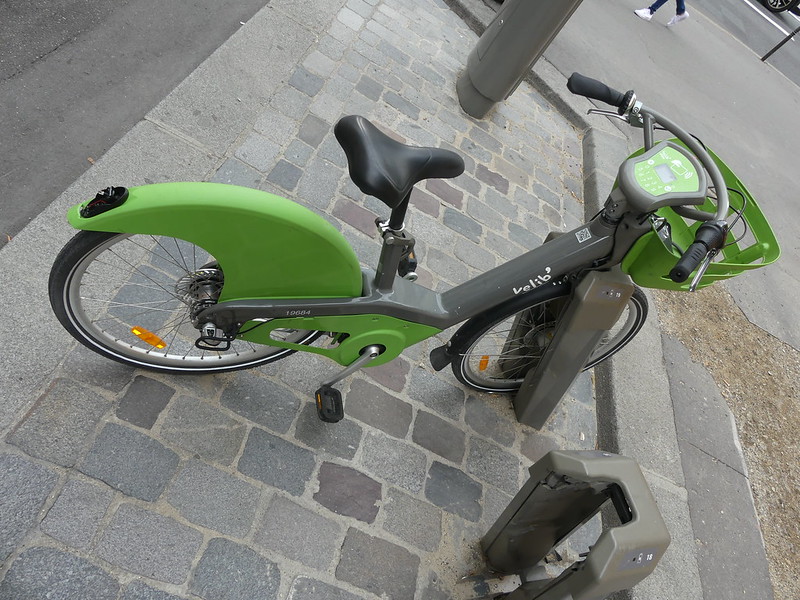
(Photo: Simone Ramella via Flickr/ CC BY 2.0)
On Choosing Velibs
All Velibs are created equal, but that does not mean they stay that way, and picking the right one from the station before you set off is the difference between the keys to the city and being shackled to the curb. Your first guide, of course, is the Velib app, which in theory offers live information on the fullness of stations and the roadworthiness of the bikes parked at them. In theory. Not to say that you shouldn’t download the app, which is an invaluable source for any serious Veliber, but it is prone to, what’s the word, lying.
Ports can sometimes be listed as full when they are empty, and vice versa, and the thing to look at when considering the bike’s roadworthiness in absentia is less the rating that its been given, but rather the amount of time that has past since the last review came in. A three star bike that received its last rating three days ago is likely as not a broken bike; three hours ago and its almost certainly ready to roll. Even so, better to think of info on the app like you might an exit poll; it suggests trends in bike number and quality, but to be sure, you have to see to Velib.
Once at the station, there are a bunch of techniques to employ to speed you selection, to know which bikes are functioning, and, more importantly, which are not stuck in their docks. Of course, there are the obvious defects: bent frame, flat tires, broken chain, but they almost go without saying. The one that catches me out most off of this list are bikes missing a peddle – it’s just not always somewhere you think to look. And granted a one-peddled Velib can be cycled in a pinch, but they’re best avoided if you can.
Beyond this, there is of course, the positioning of the saddle. It’s long been unofficial language among the Velibing community that a reversed saddle means a broken bike, and therefore one not worth your time.
Subtler tells include the height of the saddle: raised to almost its full height is best, flush with the frame and 90% of the time the bike will be a non-starter (and in the 10% of the times it does come free, you’ll probably find the saddle won’t stick anywhere apart from this lowest position, which unless you have particularly short legs, makes cycling both awkward and uncool). Any bike with its lights still on is a decent bet for functionality – as it means it’s been recently returned. It might have been returned because it was a dud to begin with, but mostly – especially at full stations – this is not the case.
An almost 100% way of eyeballing a working Velib is if it’s been raining – and has the added advantage of making you feel like Sherlock Holmes. Look for the bikes with the driest saddles, for they are the ones that have most recently been ridden. Elementary. Similarly, a good way of guessing which bikes won’t work is if there’s any rubbish left in their baskets; the more rubbish, the more certain you can be of this, but even just one plastic bottle is a bad sign. It means they’ve been sitting around for long enough for people to start using as bins.
Best of all is to catch another rider returning a bike to a dock, and ask them about the state of their vehicle. The French vocab for this, if you want to sound like a member of the Velibing fraternity, is “Il roule bien?” – lit. It drives well? In their response listen for words like freins (breaks), pneus (tires), and engrenages (gears). Chances are, if any of these get mentioned, it’s not going to be in the positive.
For real pros, meanwhile, check out the serial number on the bike frame just over the back wheel. A higher number means a newer Velib, and much more likely, not just to function, but to function well.
Finally, when it comes to removing a bike from its dock, sometimes you can bleep all the way through to the screen where it tells you it’s lock has been released, then you pull, and… it’s still lodged in place. Should this happen, there’s a chance it was just parked poorly. It’s usually worth giving it a few unscientific bashes in the centre of its handle bars to hammer it better into place, then trying again. Anecdotally, I’d wager this has a roughly 20% success rate. Again, worth it in a pinch.
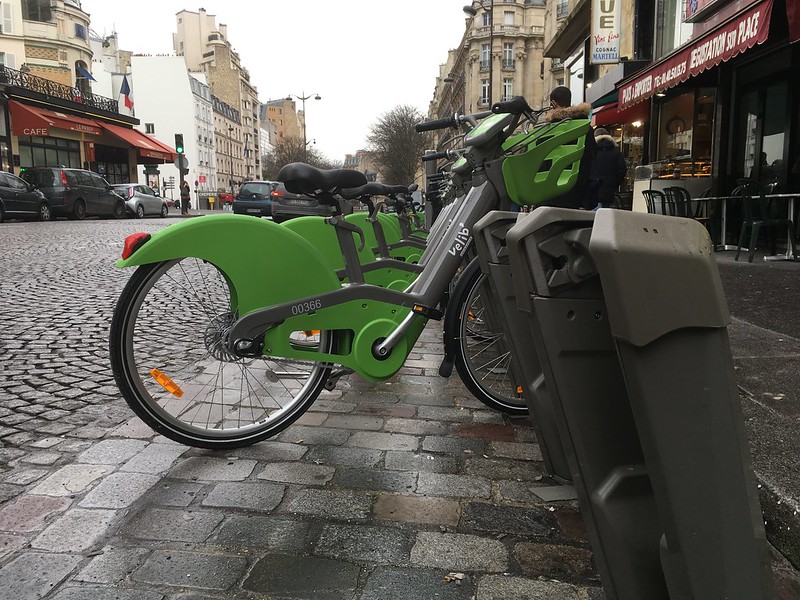
Note the serial number just over the rear wheel: the higher it is, the newer the Velib, and the more likely it will work well (Photo: Carlos Felipe Pardo via Flickr / CC BY 2.0)
On Electric Velibs
OK, so when I said all Velibs were created equal, I lied. There are normal Velibs and there are electric Velibs, and electric Velibs, while not better are, like the Dark Side of the Force, more seductive.
There’s a section in Yuval Noah Harari’s bestseller Sapiens in which he talks about the pitfalls of advancing technology. It’s debatable whether everything from the invention of agriculture to the iPhone has actually been of net benefit to human happiness, but once it’s established, it’s almost impossible to backtrack from. I think about this every time I opt for an electric Velib over a standard one. They offer less exercise and accordingly don’t fill your ride with the same endorphins as the pure peddle-power variety, but boy are they convenient, especially up hills. Electric Velibs – and electric bicycles in general, I guess – provide an experience that is something akin to the idea of cycling. They help you forget you have a body that must be hauled through the world, or rather that such hauling is meant to be hard. All this said, if an electric Velib is on offer, I opt for it every time.
The existence of electric Velibs also adds an extra node to negotiate when picking a bike. Namely, how full is its battery, and will it work. On this: the most reliable bikes to choose are those with a half-full battery bar. This implies a.) that they are in regular use, and b.) that the battery hasn’t come loose somehow. I would go so far as to say that a bike with an un-waveringly full battery is better avoided if you have the choice. It probably won’t come free from its dock (where it receives charge) and if it does, the battery likely won’t connect to the motor and you’ll be left peddling a slightly heavier bike without assistance – reminded about the weight of being in the world, even if that was precisely what you wanted to avoid.
Should an ostensibly full battery not connect, or disconnect mid-ride, you can try trouble shooting with a technique that has been around since the beginning of computers and will explain why The Singularity’s religion, when it comes, will also see as its saviour something that accomplishes a Christ-like resurrection. Turn the battery off, then on again.
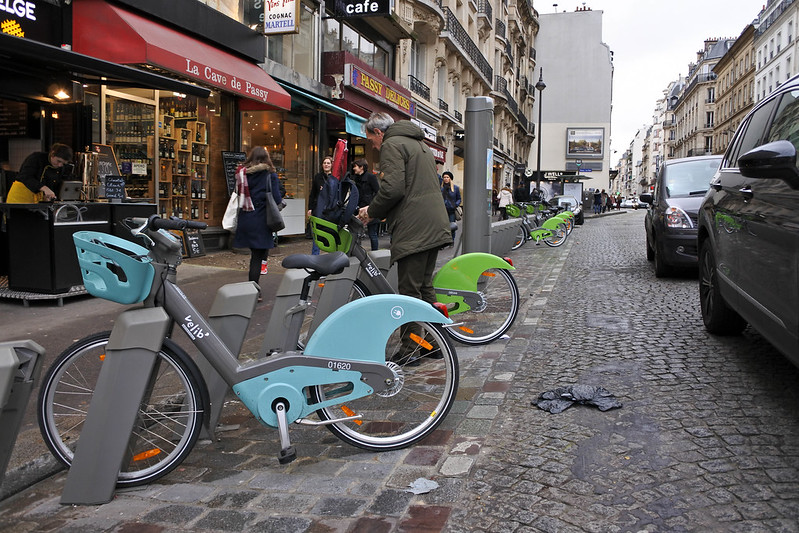
Blue, electric Velib in foreground (Photo: Carlos Felipe Pardo via Flickr/ CC BY 2.0)
On Searching vs Waiting
It’s human nature to want to feel active about controlling your destiny. And what this means in Velib terms is that when you are confronted either with an empty or a full station the instinct is to search for another where your needs will be met. Before you do this, though, it’s worth making a few mental calculations as to whether this will really speed your journey. Where are you, for example. Chances are the station is empty or full because that’s what all stations are like in this area and at this time of day, walking or cycling to another may allow you a few minutes of hope, but odds are, unless you’re crossing into a whole other idiom of Paris, that the nearest station, or even the one after that, will be blighted by the same problem. Not only that, but you will be spending a number of minutes away from any stations, in which time someone may have either arrived with a bike, or someone left with one, offering up the chance of a ride/parking to someone else in the neighbourhood, which by its nature, will be filled by a surplus of demand and a surfeit of supple.
Often then, I find it better to treat Velib stations as you might any other form of public transport. You don’t expect a metro to be sitting on the platform the moment that you descend into a station, nor a bus to be waiting at its stop to pick you up straight away; why do Velib stops have to be any different. OK, so there’s the not knowing when the next bike is going to turn up/leave, but actually that’s not true. Just because there’s no schedule, doesn’t mean traffic flows aren’t reliable. The probability of urban movement make it almost certain that your wait won’t last much more than ten minutes in most stations around the capital. This is particularly true when it comes to the central, busy stations, which though may seem perpetually complet are always having bikes removed. It is even more the case at the Velib stations closest to the major gares. A packed one of these can elicit panic if you’re running late on a train, but it’s almost always better to be Zen, and trust the flow of the city to provide.
As with every rule, however, there are exceptions. That’s why the calculation is needed; remember to take in all the factors before you resolve to wait. A rainy mid-afternoon at a desolately empty station near the peripherique? You might be waiting until nightfall for a Velib to show. This is when you need to search. Obviously, follow the app to where it says there be bikes, but also consider the invisible borders of Paris over which the directions of urban traffic might be reversed. A few blocks from Gare du Nord and Gare de l’Est, for example, you may encounter empty station after empty station, but to stand in front of the gares themselves is to cross from famine to plenty. Likewise boulevards compared to backstreets; near metro stations, the outskirts of parks, and the bottom of hills.
Similarly, if you’re headed to a major event somewhere in the city, be aware that the flow of those coming is sure to outweigh those leaving in ratios that won’t be reversed until home time. And on the weekend, too, parking in the city centre can be a nightmare, with multiple other Veliber’s circling bloated bike stations like vultures above a kill. In these cases, it’s worth thinking ahead, cutting your losses and parking up a few blocks before your intended destination. Walking the final stretch is often much more time efficient and all together less stressful than joining the frustrated, ravenous pack. This is an especially good strategy when it comes to visiting the city’s big museums. The Velib stand right by the Musée d’Orsay, for example, is in a state of near perpetual tumescence, but hop over the Boulevard Saint Michel toward Solferino and parking slots aplenty await.
On Routes to Avoid
This is far from an exhaustive list, and is even more idiosyncratic than much that’s come before. There’s a part in Bruce Chatwin’s Songlines where the author writes about how tramps have prejudices toward certain cities, less because of their actual character, but because of specific lucky or unlucky encounters they may have had in them. So it is for me and Paris streets: places I have had or almost had accidents, I regard as dangerous and better off avoided. The below, then, have been unavoidably influenced by autobiography. Anyone reading this with their own opinions about which Paris roads are best avoided, please feel free to leave them in the comments section below.
Rue de la Roquette. An innocuous street to start with, I know, for anyone familiar with Paris, but I have fallen off my bike/been knocked by passing cars more down this busy stretch leading north from Bastille than just about anywhere in the capital. It’s a combined question of width, liveliness, and traffic lights. The road does not seem so narrow as to make vehicles think they can’t pass, or make you think you can’t pass them; but it squeezes in parts and is full of parked cars. Add to that the number of pedestrians, the vans stopping for deliveries, and the constant bottle-necking at crossroads and you have a thoroughly hazardous route for the Velibers. True, everything’s moving too slowly for anything really catastrophic to occur, but still, it’s better to avoid if you can.
The rue Faubourg Saint Denis is one of my favourite streets in Paris, but not to cycle down in either direction. Similarly lively as the above, not only is there foot traffic everywhere you look, but potholes towards its southern end have a nasty way of making your wheels slip.
Avoid, if you can, rue de Rivoli, Boulevard de Sebastapol, and Boulevard de Magenta, and indeed, just about any of the major thoroughfares that have recently been improved for bicycle traffic, during both morning and evening rush hours. In theory, the new bike lanes should have made them safer, but in reality, they just seem to funnel what can feel like every cyclist in the city onto their length. And cyclists – it takes one to know one – are considerably more erratic in their respect for road rules than cars. You will find yourself jammed up behind the slowest road users, and at the same time being harried by people trying to overtake, while red lights are treated as mere suggestions. At these times – and granted only at these times – back streets are far more preferable.
I’ve no proof on this, but the rue de Bagnolet is surely the most dangerous street in Paris. It resembles the main road of a more provincial town, or from a past when urban planners did not think of cities as places where bikes had any right to be. It rages with traffic day and night, with little room to pass on either side, and worse, if you’re heading north, it’s all uphill. If you’re headed out to Montreuil, which is the main reason to take to Bagnolet, use any other route you can.
Cycling past Gare de l’Est there’s a hard to spot bump in the road where cycle lanes converge. Admittedly, I was drunk the one time I hit this, though still insist it is hard to see.
The bourgeois sixteenth arrondissement has not been set up for cycling.
Charles de Gaulle Etoile. An interesting one. In principle, I ought to say that the manic Arc de Triumph roundabout which is so chaotic that for any accident there insurance claims are automatically split both ways should under absolutely no circumstances be crossed on a bike. It is, however, a thrill. To peddle out into the maelstrom, taking your life in your hands, bobbling over the cobbles in a location of such epic beauty is a shot in the arm for the cyclist unlike any other in the French capital. Add to that, you’ll find yourself in such a state of heightened awareness that despite the ostensive danger you’re probably less likely to get into a scrape than along some of those routes actually meant for cyclists where everyone has their guard down. Probably.
Obviously, don’t go on the peériphérique.
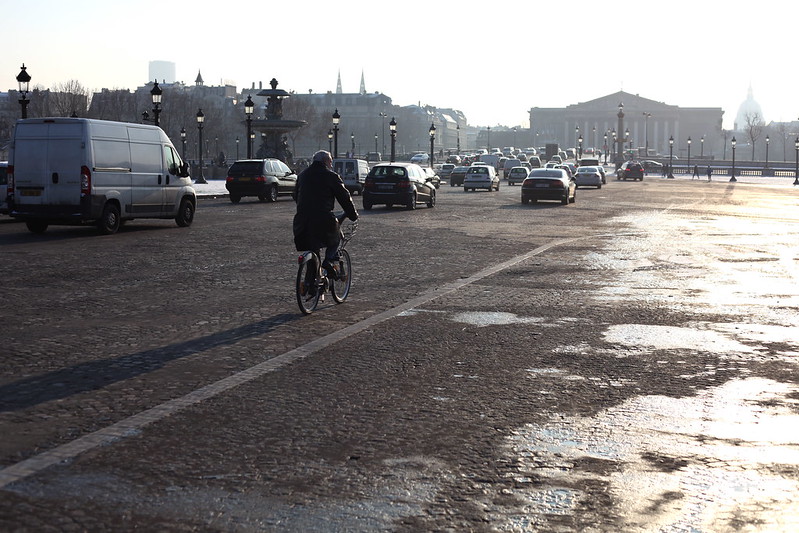
Peddling across the Place de la Concorde (Photo: Thomas van de Weerd via Flickr/ CC BY 2.0)
On Routes to Take
To freewheel from Jaures to Republique down the banks of the Canal Saint Martin in early summer is a justification for life.
Likewise dropping down onto the Seine’s pedestrianised Left Bank just west of the Pont de la Concorde. Swerve between the crowds, past boat bars and under storied bridges all the way to the foot of the Eiffel Tower.
Cross Place de la Concorde in the early dawn.
Fly pass the Louvre via the Place du Carrousel, then out over the bridge of the same name.
Figure of eight the quays of Paris’s two central islands.
Slalom through the Marais swarms.
Start at Pyrenes metro, and coast all the way down the long slope of the rue de Belleville. See Paris’s social biomes change at double time.
The parks: Vincennes and Bois de Boulogne. Bring a picnic. Bring a bottle of wine. Bring a lover or a friend.
Once again: this list is not exhaustive.